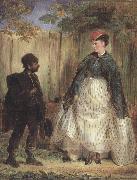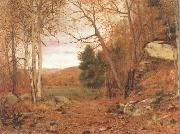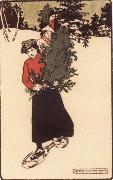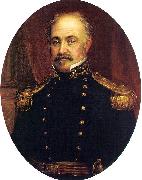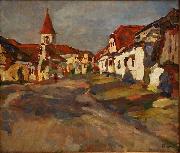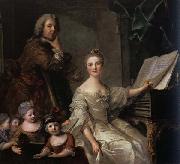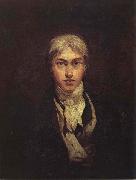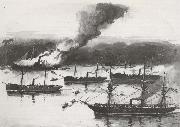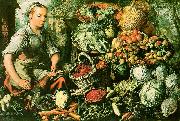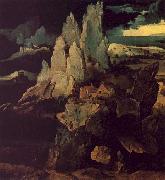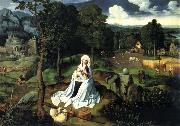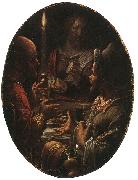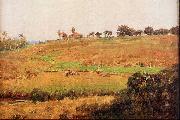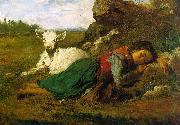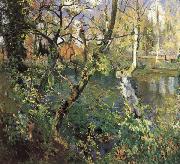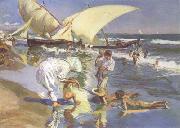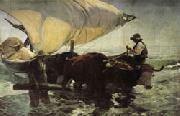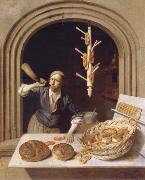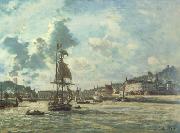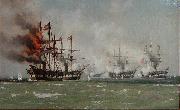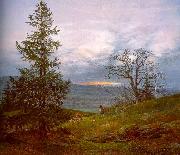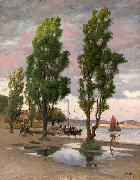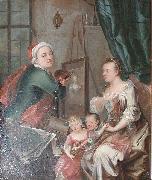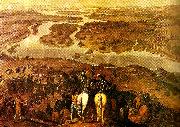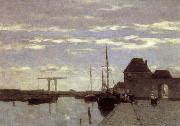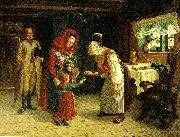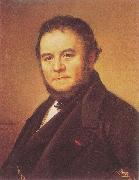|
|
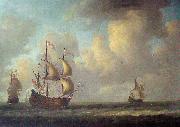 |
Jeronymus van Diest
|
|
(1631, The Hague - ca.1687, The Hague), was a Dutch Golden Age seascape painter.
According to Houbraken, a Jeronymus van Diest was good with grisailles and was the teacher of Adriaen van de Venne.[1] This grisaille painter Jeronymus Diest (I) may possibly have been a grandfather of the younger Jeronymus Diest (II); since they are both from the Hague.
According to the RKD this younger Jeronymus Diest (II) was the son of the painter Willem van Diest and the father of the painter Adriaen van Diest who was a follower of Jan van Goyen and Hendrik Dubbels.His known works are all seascapes with various ships at sail. |
|
|
|
|
|
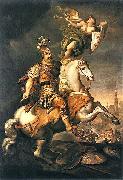 |
Jerzy Siemiginowski-Eleuter
|
|
(ca. 1660 - ca. 1711) was a prominent Polish painter and engraver of the Baroque, court painter of king John III Sobieski and a Polish-Lithuanian noble. He is considered one of the most accomplished painters of Classical Baroque in Poland, who joined in his works classical theory with genuine motives.
|
|
|
|
|
|
|
|
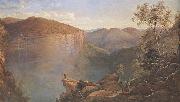 |
JH Carse
|
|
Australian Painter, ca.1819-1900 |
|
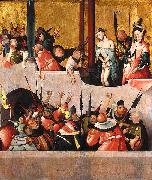 |
Jheronimus Bosch
|
|
c. 1450 - 9 August 1516), was a Dutch painter. His work is known for its use of fantastic imagery to illustrate moral and religious concepts and narratives.
Hieronymus Bosch was born Hieronymus (or Jeroen, respectively the Latin and Middle Dutch form of the name "Jerome") van Aken (meaning "from Aachen"). He signed a number of his paintings as Bosch (pronounced Boss in Middle Dutch). The name derives from his birthplace, 's-Hertogenbosch, which is commonly called "Den Bosch".
Little is known of Bosches life or training. He left behind no letters or diaries, and what has been identified has been taken from brief references to him in the municipal records of 's-Hertogenbosch, and in the account books of the local order of the Brotherhood of Our Lady. Nothing is known of his personality or his thoughts on the meaning of his art. Bosches date of birth has not been determined with certainty. It is estimated at c. 1450 on the basis of a hand drawn portrait (which may be a self-portrait) made shortly before his death in 1516. The drawing shows the artist at an advanced age, probably in his late sixties
|
|
|
|
|
|
|
|
|
|
|
|
|
|
|
|
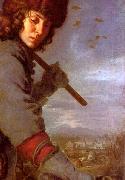 |
Joachim von Sandrart
|
|
(12 May 1606 - 14 October 1688) was a German Baroque art-historian and painter, active in Amsterdam during the Dutch Golden Age.
Sandrart was born in Frankfurt, but the family originated from Mons. According to Houbraken (who used his Teutsche Akademie as a primary source), he learned to read and write from the son of Theodor de Bry, Johann Theodoor de Brie and his associate Matthäus Merian, but at age 15 was so eager to learn more of the art of engraving, that he walked from Frankfurt to Prague to become a pupil of Gillis Sadelaar (also known as Aegidius Sadeler of the Sadeler family). Sadelaar in turn urged him to paint, whereupon he travelled to Utrecht in 1625 to become a pupil of Gerrit van Honthorst, and through him he met Rubens when he brought a visit to Honthorst in 1627, to recruit him for collaboration on part of his Marie de' Medici cycle. Honthorst took Sandrart along with him when he travelled to London. There he worked with Honthorst and spent time making copies of Holbein portraits for the portrait gallery of Henry Howard, 22nd Earl of Arundel.
Making all of those copies only served to arouse more curiosity in the young adventurer, and in 1627 Sandrart booked a passage on a ship from London to Venice, where he was welcomed by Jan Lis (whose Bentvueghels bent name was "Pan"), and Nicolaas Ringnerus. He then set out for Bologna, where he was met by his cousin on his father's side Michael le Blond, a celebrated engraver. With him, he crossed the mountains to Florence, and from there on to Rome, where they met Pieter van Laer (whose bent name was "Bamboccio"). Sandrart became famous as a portrait-painter. After a few years he undertook a tour of Italy, traveling to Naples, where he drew studies of Mount Vesuvius, believed to be the entrance to the Elysian fields described by Virgil. From there he traveled to Malta and beyond, searching for literary sights to see and paint, and wherever he went he paid his way by selling portraits. Only when he was done traveling did he finally return to Frankfurt, where he married Johanna de Milkau.
Afraid of political unrest and plague, he moved to Amsterdam with his wife in 1637.
|
|
|
|
|
|
|
|
joan miro
|
|
Joan Mir?? i Ferr?? (April 20, 1893 ?C December 25, 1983; Catalan pronunciation: was a Catalan Spanish painter, sculptor, and ceramist born in Barcelona.
Earning international acclaim, his work has been interpreted as Surrealism, a sandbox for the subconscious mind, a re-creation of the childlike, and a manifestation of Catalan pride. In numerous interviews dating from the 1930s onwards, Miro expressed contempt for conventional painting methods as a way of supporting bourgeois society, and famously declared an "assassination of painting" in favour of upsetting the visual elements of established painting. |
|
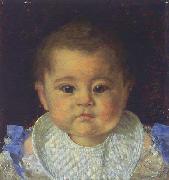 |
Joanna Mary Boyce
|
|
Joanna Mary Boyce, also known as Mrs. H. T. Wells, her married name, (7 December 1831 - 15 July 1861) was an English painter of portraits, genre pictures, and occasionally landscapes. She was the sister of pre-Raphaelite watercolorist George Price Boyce, and was herself associated with the Brotherhood.
|
|
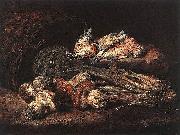 |
Joannes Fijt
|
|
(15 March 1611 - 11 September 1661) was a Flemish Baroque animal painter and etcher.
Fyt was born in Antwerp, where he was baptized on 15 June 1611, he was registered in 1621 as apprentice to Hans van den Berghe, who was a restorer of old pictures rather than a painter of new ones. Fyt then trained with Frans Snyders between about 1629-31, during which time, at the age of twenty, he entered the guild of St Luke as a master. From then until his death in 1661, he produced a vast number of paintings in which the bold facility of Frans Snyders is united to the powerful effects of Rembrandt, and harmonies of gorgeous tone are not less conspicuous than freedom of touch and a true semblance of nature.
He left Antwerp for Paris in 1633, travelling on to Italy the following year, where he worked in Venice and probably visited Rome (as he later joined the Guild of Romanists back in Antwerp). By 1641 he was back in Antwerp, where he married in 1654.
Hunting trophiesFyt excelled in the rendering of animal life in its most varied forms. He may have been less correct in outline, less bold in action than Snyders, but he was much more skilful and more true in the reproduction of the coat of deer, dogs, greyhounds, hares and monkeys, whilst in realizing the plumage of peacocks, woodcocks, ducks, hawks, and cocks and hens, he had no equal, nor was any artist even of the Dutch school more effective in relieving his compositions with accessories of tinted cloth, porcelain ware, vases and fruit.
He was not clever at figures, and he sometimes trusted for these to the co-operation of Cornelius Schut or Thomas Willeboirts Bosschaert, whilst his architectural backgrounds were sometimes executed by Quellyn. Silenus amongst Fruit and Flowers, in the Harrach collection at Vienna, Diana and her Nymphs with the Produce of the Chase, in the Belvedere at Vienna, and Dead Game and Fruit in front of a Triumphal Arch, belonging to Baron von Rothschild at Vienna, are specimens of the co-operation respectively of Schut, Willeborts and Quellyn. They are also Fyt's masterpieces. The earliest dated work of the master is a cat grabbing at a piece of dead poultry near a hare and birds, belonging to Baron Cetto at Munich, and executed in 1644. The latest is a Dead Snipe with Ducks, of 1660, sold with the Jäger collection at Cologne in 1871.
Great power is shown in the bear and boar hunts at Munich and Ravensworth castle. A Hunted Roedeer with Dogs in the Water, in the Berlin Museum, has some of the life and more of the roughness of Snyders, but lacks variety of tint and finish. A splendid specimen is the Page and Parrot near a table covered with game, guarded by a dog staring at a monkey, in the Wallace collection. With the needle and the brush Fyt was equally clever. He etched 16 plates, and those representing dogs are of their kind unique.
|
|
|
|
|
|
|
|
|
|
|
|
|
|
|
|
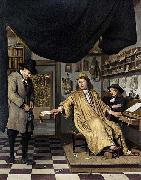 |
Job Adriaenszoon Berckheyde
|
|
(27 January 1630 - 10 June 1698) was a Dutch artist of the 17th century, active in Haarlem, Amsterdam, and The Hague.
Job Berckheyde was born in Haarlem and was the older brother of the painter Gerrit who he later taught to paint. He was apprenticed on 2 November 1644 to Jacob Willemszoon de Wet, and his master's influence is apparent in his first dated canvas, "Christ Preaching to the Children" (1661), one of his few biblical scenes. On 10 June 1653 he repaid a loan from the Haarlem Guild of Saint Luke. From 1656-1660 the two brothers made an extended trip along the Rhine to Germany, stopping off at Cologne, Bonn, Mannheim and finally Heidelberg, following the example of their fellow guild member Vincent van der Vinne. The brothers worked in Heidelberg for Charles I Louis, Elector Palatine (with Job producing portraits and hunting scenes, and receiving a gold chain from the Elector in reward) but were ultimately unable to adapt to court life and so returned to Haarlem, where they shared a house and perhaps a studio. He became a member of the Haarlem rederijkersgilde 'De Wijngaardranken' in 1666-1682. He is registered in Amsterdam 1682-1688, where he became a member of the Guild of St Luke there in 1685-1688.Berckheyde was buried in Haarlem. |
|
|
|
|
|
|
|
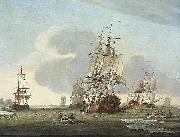 |
Jochem de Vries
|
|
painted The Zaandam shipping company Claes Tan en Zns Greenland farer Zaandam whaling in 1772
|
|
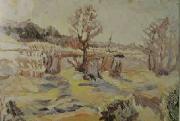 |
Joel Pettersson
|
|
(June 8, 1892 - January 5, 1937) was a painter and writer on the Åland Islands, Finland. He remained an obscure figure during his lifetime; most of his works were unpublished for decades after his death.
Pettersson was born into poverty in Lemland, Åland. His parents were elderly peasants, Joel's father being well over 50 at the time of Joel's birth. Joel had a younger brother Karl, who died at sea in 1916.
Pettersson began writing and painting in his early school years, though much of his works from this period were not preserved.
In 1913, he had the opportunity to study at a drawing school in Turku. He stayed in Turku until 1915, when he decided to abort his studies and return to Åland. He painted for a few years, but he eventually tired of it and did not paint for many years.
Upon his return, Pettersson became active in the local youth organisation, for which he wrote plays and monologues. He also wrote prose which he read out loud during organisation meetings. Pettersson was most active as a writer following his return from Turku until 1921.
During the 1920s, Pettersson worked mostly on his parents' farm, only sporadically participating in the youth organisation's activities. His parents both died in 1928, leaving Pettersson to care for the farm. He sold all the animals and most of the property. He tried earning a living on his artistry, but was unsuccessful. He then tried raising hens, but this also proved to be an unsuccessful venture. He resumed painting in 1935, and some of his paintings were displayed during an exhibition the following year.
His constant economic difficulties and work load took their toll. In 1936, he suffered a nervous breakdown and was committed to Grelsby Asylum, where he remained until his death in early 1937. |
|
|
|
|
|
|
|
|
|
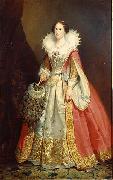 |
Johan Christoffer Boklund
|
|
(15 July 1817 - 9 December 1880) was a Swedish history, genre, and portrait painter from Kulla-Gunnarstorp in Scania.He was the son of a gardener. At the age of fifteen, Boklund came to Lund, where he worked on illustrations for Sven Nilsson's works on Scandinavian fauna (under the supervision of Magnus Körner). He then became a student at the Royal Danish Academy of Fine Arts in Copenhagen where J. L. Lund was his teacher.
In 1837, Boklund went to Stockholm and began studying at the Royal Swedish Academy of Arts. He made a living as a lithograph and drawing teacher, and produced several small genre paintings of the everyday life (such as Flicka med blomster (English: Girl with flowers) and Köksinteriör (English: Kitchen interior)) and history paintings of the 17th century (such as Gustaf Adolfs afsked från Maria Eleonora (English: Gustaf Adolf's farewell from Maria Eleonora), which was awarded with a medal at the academy).
Together with fellow Swedish painter Johan Fredrik Höckert, Boklund traveled to Munich in Germany in 1846 and stayed there for eight years. During the summers he went on study trips to Bavaria, Tyrol, and northern Italy. During this period, Boklund primarily devoted his painting to the history genre with subjects from the 17th century, but he also made some paintings depicting picturesque and architectural interior. In 1853, he sent his painting Den nyfikne trumpetaren (English: The curious trumpet player) home to Sweden and it earned him a scholarship from the government. This allowed Boklund to move to Paris, where he worked at Thomas Couture's atelier from 1854 to 1855. In December 1855 he returned to Sweden. |
|
|
|
|
|
|
|
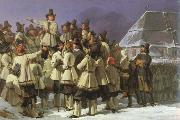 |
johan gustaf sandberg
|
|
Johan Gustaf Sandberg, född 1782, död 1854, var målare; han var professor i teckning vid Konstakademien från 1828, och direktör där 1845?C1853.
Sandberg ägnade sig främst åt historiemåleri, med motiv ur nordisk mytologi och svensk historia. Hans främsta verk inom detta område är kalkmålningarna över Gustav Vasa i Uppsala domkyrka. Han målade också en mängd porträtt.
Sandberg blev 1794 elev i konstakademins principskola och 1801 i antikskolan, lärde samtidigt musik och klaverspelning och tjänade pengar genom lektioner och genom arbete på kungliga teaterns dekorationsmålarverkstad. Under den följande tiden slöt han sig till den opposition mot akademin, som hade sin medelpunkt i "Sällskapet för konststudium". Tvisten med akademin lade sig snart, Sandberg valdes till ledamot 1821 och blev ordinarie professor 1828. Däremot hade han aldrig tillfälle att göra den för äldre tiders konstnärer obligatoriska studieresan till södern.
Han utförde teckningarna till praktverket "Ett år i Sverige" (1827 -35) med bilderna graverade under Christian Didrik Forssells ledning och texten skriven av Anders Abraham Grafström. Under upprepade sommarvistelser på Säfstaholms slott målade Sandberg folktyper och folkdräkter.
Åtskilliga porträtt utförde Sandberg för det praktfulla "Galleri af utmärkta svenska lärde, vetenskapsidkare och konstnärer", som han utgav 1835?C42 (100 porträtt, litograferade av J. Cardon).
|
|
|
|
|
|
|
|
 |
johan krouthen
|
|
född 2 november 1858, död i december 1932, var en svensk idealistisk konstnär.
Krouth??n föddes i Linköping och var son till handlaren Conrad Krouth??n och Hilda Åberg. Släkten Krouth??n kom från Norrköping och flera generationer hade arbetat som tenngjutare. Familjenamnet Krut ändrades genom att varubeteckningen Krut-tenn förfranskades till Krouth??n. Conrad Krouth??n kom till Linköping 1850 och startade en manufakturaffär vid Stora torget. Affären gick bra och 1857 kunde han gifta sig med sömmerskan Hilda Åberg.
Krouth??n kunde växa upp i ett välmående hem och han fick börja skolan på läroverket i Linköping. Vid 14 års ålder slutade han skolan och började arbeta åt fotografen och målaren Svante Leonard Rydholm som hade en atelj?? vid St. Larsplan. Krouth??n fick lära sig grunderna i både målning och fotografering och vid 16 års ålder började han på Konstakademiens principskola i Stockholm 1875. Den treåriga utbildningen innebar att eleverna fick lära sig att rita av klot och profiler, djur och växter. Efter de tre åren fick Krouth??n fortsätta vid akademin. I kursen "Lägre antiken" fick eleverna rita av gipsmodeller, i "Högre antiken" teckna efter levande model och i "Landskapsskolan" fick eleverna måla landskap. Under studietiden sökte sig många elever utanför skolan och Krouth??n lärde känna konstnären Edvard Pers??us. Perseus var kritisk till utbildningen på akademin och tog med sina elever bland annat till Mariefred och Gripsholms slott för att måla av naturen. |
|
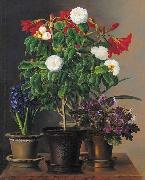 |
Johan Laurentz Jensen
|
|
(8 March 1800, Gentofte - 26 March 1856, Copenhagen) was a Danish artist who specialized in flower painting.
In parallel with his studies at the Danish Academy, he became a pupil of Christoffer Wilhelm Eckersberg and also of Cladius Detlev Fritzsch. Specializing in flower painting, Jensen continued his education in Paris under the Flemish flower painting brothers, Gerard and Cornelis van Spaendonck, and at the porcelain factory in Sevres where he learnt the art of miniature flower painting. Taking 17th-century Dutch flower painting as a starting point, he revived the art in Denmark. His floral arrangements often had both a decorative and symbolic value. Danish plants were often accompanied by exotic flowers and fruits, sometimes even birds. He also became head artist at the Danish Procelain Factory. Jensen had an extensive circle of customers and many students, especially women, including Louise of Hesse-Kassel who later married King Christian IX. Since the 1980s, his works have gained wide international recognition. Many are exhibited in Statens Museum for Kunst and in Thorvaldsens Museum. |
|
|
|
|








